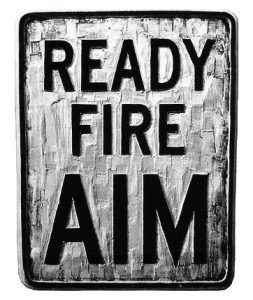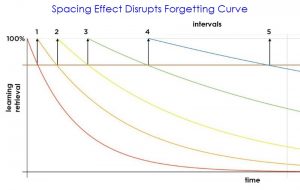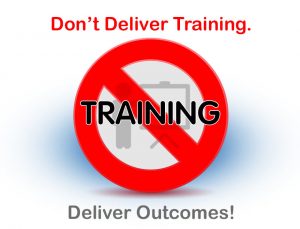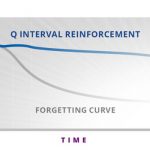
How Learning & Development Can Prove Training’s Value to Leadership
Learning & Development’s Quest for Better Training Outcomes
Monty Python and the Holy Grail is a cult-classic comedy about King Arthur’s knights and their quest for the Holy Grail. Certainly, Learning & Development professionals have their own ongoing quest: proving training’s impact on the business.
If you aren’t familiar with the movie, watch this 2 minute video clip of the famous bridge-of-death scene. If we refilmed that and gave it an L&D slant, it would probably go something like this:
- KEEPER: Stop! Who would cross the Bridge of Death must answer me these questions three, ‘ere the other side she sees.
- REBECCA: Ask me the questions, bridge-keeper. I’m not afraid.
- KEEPER: What is your name?
- REBECCA: My name is Rebecca, Senior Learning Executive at BigCo.
- KEEPER: What is your quest?
- REBECCA: To drive better performance outcomes from employee training!
- KEEPER: How do you prove outcomes were caused by your training?
- REBECCA: What? I don’t know that. Ahhhhhhhhhhhhhhh…
Proving business impact is a high priority for today’s learning executive. After all, your goal is not to deliver training. Your goal is to deliver business outcomes. Like the bridge-of-death scene, there are three questions that must be addressed to complete your quest and to earn your place at the Executive Round Table:
- Are you a strategic partner? Too often, training is a tactical reaction to customer requests, creating missed opportunities for L&D to play a more strategic role.
- Have you established a continuous learning culture? Are you ticking the training event box, or are your programs focused on continuous improvement?
- Are you proving training impact? Claiming performance improvement is one thing. Proving it is quite another.
Are you a strategic partner?
 If doctors prescribed medicine before understanding symptoms, they would lose their license. Similar malpractice occurs when Learning & Development reacts to training requests without first understanding the need. L&D must diagnose before it prescribes.
If doctors prescribed medicine before understanding symptoms, they would lose their license. Similar malpractice occurs when Learning & Development reacts to training requests without first understanding the need. L&D must diagnose before it prescribes.
In DELIVER RESULTS, NOT JUST TRAINING, Bob Pike suggests L&D should operate proactively like a business to create true operational alignment. Running like a business means asking questions, understanding needs, identifying strengths and weaknesses (SWOT), agreeing to desired outcomes and defining how to measure success. Taking this information-centric approach creates more consistent training outcomes while increasing L&D’s credibility inside the enterprise.
Have you established a continuous learning culture?
When employees remember only 50% of their training, that means half of their time-in-training has gone to waste. For larger enterprises, that’s millions of dollars in opportunity costs. It also means training outcomes fail to reach their full potential. How much would it impact overall learner confidence and performance if employees remembered 90% of their training instead of 50%?
 Maximizing training outcomes means what happens after training is as important as what happens during training. The Forgetting Curve is real: Employees quickly forget over 50% of their training post-event. To maximize learning impact, L&D must disrupt the forgetting curve. The forgetting curve was first discovered 130+ years ago by Hermann Ebbinghaus. Modern learning studies prove techniques like the Spacing Effect, Retrieval Practice, Interleaved Practice, Feedback and Repetition are very effective disruptors of the forgetting curve. Years ago, these tactics were too resource-intensive for Learning & Development to implement. L&D often settled for collecting anecdotal feedback via monthly surveys. Data collected from these surveys was entirely subjective, and therefore less credible. More importantly, these surveys did nothing to support the learners post-training.
Maximizing training outcomes means what happens after training is as important as what happens during training. The Forgetting Curve is real: Employees quickly forget over 50% of their training post-event. To maximize learning impact, L&D must disrupt the forgetting curve. The forgetting curve was first discovered 130+ years ago by Hermann Ebbinghaus. Modern learning studies prove techniques like the Spacing Effect, Retrieval Practice, Interleaved Practice, Feedback and Repetition are very effective disruptors of the forgetting curve. Years ago, these tactics were too resource-intensive for Learning & Development to implement. L&D often settled for collecting anecdotal feedback via monthly surveys. Data collected from these surveys was entirely subjective, and therefore less credible. More importantly, these surveys did nothing to support the learners post-training.
We need to graduate from delivering effective training to training effectiveness. – Jim Kirkpatrick, Kirkpatrick Partners
That was then, but this is now. Today, technologies like Adaptive MicroLearning makes it much easier to disrupt the forgetting curve without requiring a large resource commitment. Spaced reinforcement sessions can be delivered to users on a recurring schedule. In each bite-sized delivery, knowledge checks, polls and scenario-based quiz questions evaluate learner readiness and then prescribe feedback, reinforcement and repetition to close each user’s learning gaps. By adapting to the needs of the individual, these sessions systemically improve learner confidence and accelerate successful training application. Also, learning gap analytics collected in the process provide leading indicators to management on training alignment, coaching opportunities and areas at risk. Measurement replaces hope as an actionable strategy.
Are you proving training impact?

Let’s say you delivered product training to the sales force and revenue improved 20% that quarter. Did you get a big promotion? Did you get a huge bonus? Did they at least throw you a party? Probably not. Why? Because there were seven operational levers pulled by leadership to improve sales that quarter. Training was merely one of those levers. This makes it impossible to directly attribute performance lift to the training.
There are so many factors that influence performance. Maybe the economic climate got better during that period. Maybe some deals in the pipeline received special incentives to close by the end of the quarter. Maybe it was the new marketing campaign. Maybe…
Too many “maybes” impede L&D’s ability to prove they are improving performance and not just ticking the training box. Collecting anecdotal feedback from your target audience and their managers will provide some insights to L&D, but combining feedback with hard performance data will quickly get the attention of your operational stakeholders.
Conduct an A/B Test
An A/B Test is the best way to prove training’s impact. A/B tests allow you to isolate training’s impact from other contributing factors. The first step of a successful A/B Test is getting your executive sponsor on-board. Proposing an A/B Test to her/him shows L&D cares about improving performance. Occasional A/B Tests also provide valuable insights on what works and what doesn’t so L&D’s approach improves for the next initiative. Here is a summary of conducting a successful A/B Test:
- KPIs: Agree to qualitative and quantitative measures used to determine training impact. Define how long it should take to see a noticeable performance change.
- Benchmark Performance: Gather audience performance data/KPIs pre-training
- Divide Audience in Half: Deliver training to only half your audience (Group A). The other half (Group B) maintains the status quo.
- Analyze Data: Compare KPI trends for both groups to draw insights.
- Make Recommendations: Learn and improve.
Its hard to argue with this approach, as it is the only credible way to isolate training’s impact on the business. It is also the third and final step in completing your quest for better training outcomes.
An organization’s ability to learn, and translate that learning into action rapidly is the ultimate competitive advantage. – Jack Welch, former CEO@GE
So now what?
Read the following sentence out loud:
The sole purpose of workforce training is to improve performance.
Louder! 🙂
The sole purpose of workforce training is to improve performance!
Write this sentence down. Tape it to your bathroom mirror and to your computer monitor. Read it out loud every day. If you internalize this sentence – really internalize it – then being a strategic business partner, creating a continuous learning culture and measuring training’s ongoing impact will soon become second nature.
Here’s to better training outcomes!



